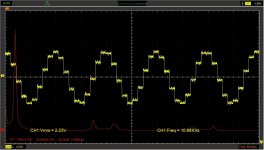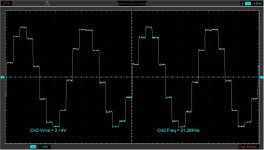Last night I first listened to AD1856 and then put in AD1860 and continued with that. As far as I know, it plays very similar. I don't have a PCM56 on hand to compare, but I believe there isn't much of a difference. What I noticed, the AD1856 and AD1860 are defined at 8x44.1kHz=352.8kHz. AD1856 wants to work 24bit 192kHz and AD1860 won't, it ends at 24bit 96kHz. At 192kHz it has a metallic undertone. PCM56 I think is defined at 4x44.1kHz=176.2kHz.
I bought this AD1860N-T made in 1989, but I don't know what this T means. Maybe N-K works better? In any case it doesn't sound bad with the Burson V5, I have to try other OPAs, you never know what a good combination is. In any case, these chips are cheap, you can buy them and try them.
I don't think I'll experiment with this any further, now I'm primarily interested in the PCM1702.
I bought this AD1860N-T made in 1989, but I don't know what this T means. Maybe N-K works better? In any case it doesn't sound bad with the Burson V5, I have to try other OPAs, you never know what a good combination is. In any case, these chips are cheap, you can buy them and try them.
I don't think I'll experiment with this any further, now I'm primarily interested in the PCM1702.
Last edited:
I have no idea. It's not a bad thing to listen to. Maybe I'll take the AD1860N-K for a test sometime. I'm planning this DAC for my brother, I'll just add an Amanero USB card. I just need one small transformer 12+12V and power supply. The simplest possible. I bought for this a Chinese display that shows the frequency from the LR signal.
Ruach ran out of supply, as communicated to me recently., 😔I already asked Rauch, but he disappeared without any note. Not any sign from him since last year.
Guys, is it a modern life obligation than someone should always answer when he is asked unilateraly something ?
After two and a half days, I bring back AD1856. It's a better DAC than AD1860. At first I thought AD1860 was an improvement, but it wasn't.
As for OPAs for AD1856, I like the SS3601 best in this combination, followed by OPA 1641A and Burson V5. In principle, it is appropriate to take only OPA 1641A for this cheap DAC. Sparkos is slightly better, but the price difference is too big.
I wrote a few days ago that the AD1856 works at 24bit 192kHz. However, it will not work purely on that frequency, only 24/96. I probably mixed something up with AD1865.
As for OPAs for AD1856, I like the SS3601 best in this combination, followed by OPA 1641A and Burson V5. In principle, it is appropriate to take only OPA 1641A for this cheap DAC. Sparkos is slightly better, but the price difference is too big.
I wrote a few days ago that the AD1856 works at 24bit 192kHz. However, it will not work purely on that frequency, only 24/96. I probably mixed something up with AD1865.
@BRN So it is. Moreover oversampling and digital filters sometimes hit and sometimes miss the lost parts of recorded audio source. In addition, some types of filters can add so-called "ringing" (mainly FIR filters). It is excellent for recreating periodic waves (like the constant sine), but not so accurate for creating sound patterns. Recordings are more natural to listen to with "missing parts" than with "guessings". From my belief that's the reason why a good NOS DAC is so pleasant and not tiring to listen to, because it's closest to reality 😉
Miro, all, I am using the JLSounds board. For the TDA1541, should the JLSounds board be configured in I2S mode or simultaneous mode? Getting no sound in the I2S mode config. Thanks!
He is mostly right, these are known things, I mean it is pure mathematics. That's how it was originally designed to work.Thought this was a well put together video for us lovers of old school DAC chips.
16bit Audio
I just don't understand the statement that the step signal does not exist at any stage of the process. Here are attached two recordings of the output from NOS DACs, AD1865 and PCM63. To get a pure sine signal from this, a sharp filter is needed to remove all harmonics.
Attachments
You listened to my Mobo vs Pcm63P. The three of us were sitting and couldn't tell the difference. But there is no ΔΣ on the motherboard. ALC works differently.😎a sharp filter is needed to remove all harmonics.
- Home
- Source & Line
- Digital Line Level
- DAC AD1862: Almost THT, I2S input, NOS, R-2R


